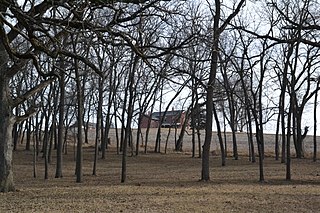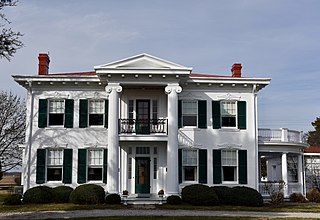
The Mahaffie Stagecoach Stop and Farm Historic Site, locally known as the Mahaffie farmstead, is located in Olathe, Kansas. The house was originally a stop along the Oregon and California Trails, which originated in nearby Westport, Missouri. The house's heyday came with large numbers of westbound travelers of the 1860s.

Shiloh Indian Mounds Site (40HR7) is an archaeological site of the South Appalachian Mississippian culture. It is located beside the Tennessee River on the grounds of the Shiloh National Military Park, in Hardin County of southwestern Tennessee. A National Historic Landmark, it is one of the largest Woodland era sites in the southeastern United States.

The Thorstein Veblen Farmstead is a National Historic Landmark near Nerstrand in rural Rice County, Minnesota, United States. The property is nationally significant as the childhood home of Thorstein B. Veblen (1857-1929), an economist, social scientist, and critic of American culture probably best known for The Theory of the Leisure Class, published in 1899.

The George Markell Farmstead, also known as Arcadian Dairy Farm and the Thomas Property, is a historic home and farm complex located at Frederick, Frederick County, Maryland, United States. It consists of brick house built about 1865, a brick smokehouse, a bake oven, two stone domestic outbuildings, an ice house, a springhouse, a frame stable, a frame chicken house, a mid-20th century guest house, and various sheds and outbuildings. Nearby is a large gambrel-roofed concrete block barn. The main house has combined Greek Revival and Italianate stylistic influences. The once large Markell dairy farm, with its lane to the Ballenger Creek ford of the Monocacy River, served as the primary approach route to the battlefield by Confederate troops during the July 9, 1864 Battle of Monocacy during the American Civil War.

Garden Hill, also known as the Robert Cushen farmstead, is a historic home located at Hagerstown, Washington County, Maryland, United States. It was built about 1865, and is a two-story five-bay brick dwelling with a formal facade and a central entrance. The house features Greek Revival detailing, with some Gothic Revival influence in interior trim.

The Sweeney-Conner cabin is a structure within the Appomattox Court House National Historical Park. It was registered in the National Park Service's database of Official Structures on June 26, 1989.

Peter Peterson Farmstead, also known as Emel Peterson Farmstead, near Waverly, Nebraska, United States, dates from 1893. It was listed on the National Register of Historic Places in 1980.

Philip Friend House is a c. 1807 historic farm house in North Bethlehem Township, Pennsylvania, US. The stone house is forty feet by thirty feet, two-story, five-bay, and gable-roofed. Contributing outbuildings include a barn, springhouse, wash house, and privy.

Robert Parkinson Farm is a historic property in Morris Township, Pennsylvania. The contributing buildings are the c. 1830 house, c. 1830 banked barn, c. 1870 sheep barn, c. 1880 hay shed, c. 1880 spring house, and a c. 1920 privy. The house is a five-bay center passage farmhouse with an attached rear kitchen in a T-shaped floor plan. The Parkinson Farm is an example of an early 19th-century sheep farm, and it continued to operate as such until about 1960.

Stephenson–Campbell House, also known as the Stephenson–Campbell Property and the Stephenson Log House, is a historic site in Cecil, Pennsylvania containing four contributing buildings. Included are a 1778 log house, a 1929 Sears and Roebuck Company mail order bungalow style house, a 1929 spring house, and a 1928 garage. The log house is 16 feet by 34 feet, with several additions totaling about 1360 square feet. The log house is one of the few pre-1780 log houses still standing in Western Pennsylvania, and the only known example of a single story private home still extant in the area.

Isaiah Warner Farmstead is a historic home and farm located in Wrightstown Township, Bucks County, Pennsylvania. The original section of the house was built in 1793, with additions dated to about 1830 and 1935. It is a 2 1/2-story, stone farmhouse with a slate covered gable roof constructed in three sections. It measures 64 feet long and approximately 20 feet deep and is in the Federal style. Also on the property are two two-story, 19th century frame barns; and a shed, corn crib, and chicken house dated to the early 20th century.

Duncan Farm is an archaeological site located on a farmstead south of Illinois Route 100 in Jersey County, Illinois, near the city of Grafton. The site, which dates from the Woodland period, includes two burial mounds and a habitation site. The site was part of the Hopewell exchange system in Illinois and is the closest neighboring village site to the Golden Eagle regional transaction center, a major trade and social hub in the system. Archaeologists have suggested that the site is a local transaction center in the Golden Eagle site's region due to its two large mounds, which are roughly 200 feet (61 m) long and 100 feet (30 m) wide each. In addition, the site is archaeologically significant due to its distinctive stratification, which allows its artifacts to be easily dated.

Venoge Farmstead, also known as the Louis Gex Oboussier Farm and Vineyards, is a historic home and farm located in Craig Township, Switzerland County, Indiana. The house was built about 1805, and is a 1 1/2-story, rectangular frame cottage in a vernacular French Colonial style. It has a side gable roof and measures 18 feet by 38 feet, including an integral front porch.

Nelson–Pettis Farmsteads Historic District, also known as Poverty Hill, is a national historic district located at St. Joseph, Missouri. The district encompasses four contributing buildings, three contributing sites, and one contributing structure on two adjoining farmsteads - the Nelson farmstead and the Pettis farmstead. The contributing resources are the Nelson I-house farmhouse, root cellar, the Nelson family cemetery, the Pettis farmhouse, the barn, the corn crib / shed, and the agricultural fields.

Big Hill Farmstead Historic District is a historic home and farm and national historic district located at Jackson, Cape Girardeau County, Missouri. The farmhouse was built about 1855, and is a two-story, five bay, brick I-house with Greek Revival and Italianate style design elements. It has a hipped roof and features a gallery porch. Other contributing elements are the a timber frame barn, a cabin/workshop, a wagon shed, and the surrounding farmland.

Brehe Farmstead Historic District, also known as the Fairview Stock Farm, is a historic home, farm, and national historic district located at Washington, Franklin County, Missouri. The farmhouse was built about 1869, and is a two-story brick dwelling. The other contributing buildings are the brick smokehouse/ dwelling combination, a frame poultry house (1940s), a large frame granary, a Quonset barn, a small frame milk house, and a large gambrel roofed bank barn with a round ceramic block silo.

Culbertson–Head Farmstead is a historic home, farm, and national historic district located near Palmyra, Marion County, Missouri. The house was built about 1854–1855, and is a two-story, "L"-shaped, Greek Revival style brick dwelling. It features a two-story front portico. Also on the property are the contributing smokehouse / ice house (pre-1915); shop ; large Jamesway, gambrel roof barn (1927); gabled roofed, wood granary ; and transverse crib barn (1880s).

Louis Bruce Farmstead Historic District, also known as Rock Enon Farm, is a historic home and farm and national historic district located near Russellville, Moniteau County, Missouri. The district encompasses six contributing buildings and one contributing structure associated with a late-19th century farmstead. They are the house (1872-1876), a smokehouse / multipurpose building (c.1870-76), a privy, a spring house (1873), a granary, a substantial barn (1870), and a stone retaining wall with a swinging iron gate and carriage steps. The house is a 2 1/2-story, five bay, central hall I-house constructed of limestone blocks. It has a gable roof and a three-bay front porch.

J. F. Schroer House-Store is a historic home and store located at Augusta, St. Charles County, Missouri. The house was built about 1865-1866, and is a 2 1/2-story, brick dwelling with a central passage plan. The store occupied the first floor with living quarters above. It measures approximately 50 feet wide by 36 feet deep and has a side-gable roof and wine cellar.

The Somerville Barn, also known as the Caltrider Barn, is part of a farmstead located at 1050 North College Road in Alaiedon Township, Michigan. It was listed on the National Register of Historic Places in Michigan in 2005.



























